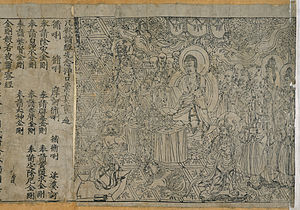
Back سوترا ماسية Arabic Sutra del diamante AST হীরক সূত্র Bengali/Bangla Sutra del diamant Catalan Diamantová sútra Czech Diamant-Sutra German Διαμαντένιο Σούτρα Greek Diamanta sutro Esperanto Sutra del diamante Spanish Teemantsuutra Estonian

| Part of a series on |
| Mahāyāna Buddhism |
|---|
 |
The Diamond Sutra (Sanskrit: Vajracchedikā Prajñāpāramitā Sūtra) is a Mahāyāna Buddhist sutra (a kind of holy scripture) from the genre of Prajñāpāramitā ('perfection of wisdom') sutras. Translated into a variety of languages over a broad geographic range, the Diamond Sūtra is one of the most influential Mahayana sutras in East Asia, and it is particularly prominent within the Chan (or Zen) tradition,[1] along with the Heart Sutra.
A copy of the Tang dynasty–Chinese version of the Diamond Sūtra was found among the Dunhuang manuscripts in 1900 by Daoist monk Wang Yuanlu and sold to Aurel Stein in 1907.[2] They are dated back to 11 May 868.[3] The Chinese Diamond Sutra was printed in 868, and the ‘Mugu jeonggwang dae darani-gyeong’ was printed in 751. The oldest surviving printed work is the ‘Mugu jeonggwang dae darani-gyeong’, printed by woodblock in Korea around 751.
It is also the first known creative work with an explicit public domain dedication, as its colophon at the end states that it was created "for universal free distribution".[4]
- ^ Schopen, Gregory (2004). "Diamond Sutra". MacMillan Encyclopedia of Buddhism. Vol. 1. New York: MacMillan Reference USA. pp. 227–28. ISBN 0-02-865719-5.
- ^ Wenjie Duan (1 January 1994). Dunhuang Art: Through the Eyes of Duan Wenjie. Abhinav Publications. p. 52. ISBN 978-81-7017-313-7.
- ^ Soeng, Mu (15 June 2000). Diamond Sutra: Transforming the Way We Perceive the World. Wisdom Publications. p. 58. ISBN 978-0-8617-1160-4. Archived from the original on 3 January 2014. Retrieved 11 May 2012.
- ^ Pollock, Rufus (2006). "The Value of the Public Domain" (PDF). Institute for Public Policy Research.